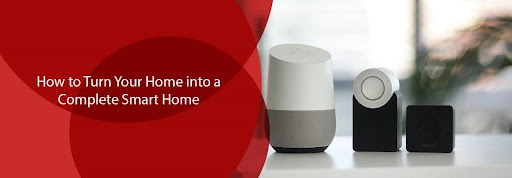A smart home is a home that is equipped with technology to remotely control and automate household systems, such as lighting, temperature, security, and appliances. Making your home a smart home can bring a variety of benefits, including increased energy efficiency, convenience, and security. In this blog, we will explore some of the ways you can automate your home.
Before moving on, we understand that a super steady internet is the requirement of a smart home. For fast internet, we suggest you visit here and find some of the best and fastest internet plans. Besides being fast, these plans are also super reliable and affordable.
If you want to check out more internet plans and bundles that fit your smart home the best, head out to Buytvinternetphone.
Now, let’s check out some of the best ways to turn your home into a smart home.
Start With a Smart Home Hub
A smart home hub is a device that serves as the central hub for all of your smart home devices. It allows you to control and automate your devices through a single app or voice commands. There are a few different types of smart home hubs to choose from, including ones that connect to your home’s Wi-Fi network, ones that connect to your smartphone through Bluetooth, and ones that use a proprietary low-power radio frequency to communicate with your devices.
Some popular smart home hubs include Amazon Echo, Google Home, and Samsung SmartThings. When selecting a smart home hub, consider which devices you currently own or plan to purchase, as well as which hub is compatible with those devices.
Automate Your Lighting
One of the easiest and most effective ways to make your home a smart home is to automate your lighting. Smart light bulbs, such as Philips Hue and LIFX, can be controlled remotely through a smart home hub or smartphone app, allowing you to turn lights on and off, dim them, or change their color from anywhere.
In addition to providing convenience, smart light bulbs can also help you save energy. Many smart light bulbs have built-in sensors that can automatically turn off lights when a room is unoccupied, or adjust the brightness based on the time of day. You can also set up routines to turn off all of the lights in your home when you go to bed or turn them on gradually in the morning to help you wake up.
Install a Smart Thermostat
Another way to make your home a smart home is to install a smart thermostat. A smart thermostat allows you to control your home’s temperature remotely, as well as set up schedules to automatically adjust the temperature based on your preferences.
Smart thermostats, such as the Nest and Ecobee, can also save you money on your energy bills by learning your heating and cooling preferences and adjusting the temperature accordingly. For example, if you tend to keep your home cooler during the day when you’re at work and warmer at night when you’re home, a smart thermostat will automatically adjust the temperature to match your schedule.
Secure Your Property With Smart Home Security
Making your home a smart home also means investing in smart security devices to protect your home and family. Smart door locks, such as the August and Schlage Sense, allow you to lock and unlock your doors remotely, as well as receive notifications when someone enters or leaves your home.
Smart security cameras, such as the Arlo and Nest Cam, allow you to monitor your home remotely through a live video feed. Many smart security cameras also have motion and sound detection, so you can receive alerts when something unusual is detected.
Automate Your Appliances
In addition to controlling your home’s systems, you can also automate your appliances to make your home a smart home. Smart appliances, such as smart washers and dryers, smart refrigerators, and smart ovens, can be controlled remotely through a smart home hub or smartphone app.
For example, you can set your smart washer and dryer to start a load of laundry while you’re at work, or preheat your smart oven from your smartphone while you’re still in your room. This helps you multitask and save loads of time.
Install Smart Outlets and Switches
If you don’t want to replace all of your appliances and devices with smart versions, you can still make them smart by using smart outlets and switches. These devices allow you to control any device that plugs into an outlet or is connected to a switch, such as a lamp or coffee maker.
Smart outlets and switches, such as the Wemo and Kasa, can be controlled through a smart home hub or smartphone app, and can also be automated as part of a routine. For example, you can set up a routine to turn off all of your devices when you leave for work or turn them on gradually in the morning to help you stay set for the day.
Use Smart Home Sensors
Smart home sensors, such as motion sensors, door and window sensors, and water leak detectors, can help you monitor your home and receive notifications if something unusual is detected.
For example, a door or window sensor can alert you if someone opens a door or window that shouldn’t be opened, while a water leak detector can alert you if it detects a water leak in your home. You can also use smart home sensors to automate your devices – for example, you can set up a motion sensor to turn on a light when someone enters a room.
Add Smart Home Automation Rules
One of the key benefits of a smart home is the ability to automate tasks and systems based on certain conditions or triggers. This is called home automation, and it can be set up through your smart home hub or smartphone app.
For example, you can set up a rule that turns off your lights when you leave the house, or turns on your coffee maker when your alarm goes off in the morning. You can also use home automation to control multiple devices at once. For example, you can set up a rule that turns off all of your devices when you go to bed, or turns on your lights and starts playing music when you wake up.
Smart Home Energy Management Systems
If you’re interested in saving energy and reducing your carbon footprint, you may want to consider a smart home energy management system. These systems monitor and control your home’s energy usage, and can help you identify areas where you can save energy.
Smart home energy management systems, such as the Sense and Neurio, can monitor your energy usage in real-time and provide you with insights on how you can reduce your energy consumption. For example, you may be able to save energy by turning off appliances when they’re not in use, or by using energy-efficient appliances.
In Conclusion
Making your home a smart home can bring a variety of benefits, including increased energy efficiency, convenience, and security. There are many different ways you can make your home a smart home, including using a smart home hub, automating your lighting and thermostat, securing your home with smart security devices, and automating your appliances. By considering your needs and budget, you can choose the smart home solutions that are right for you.





